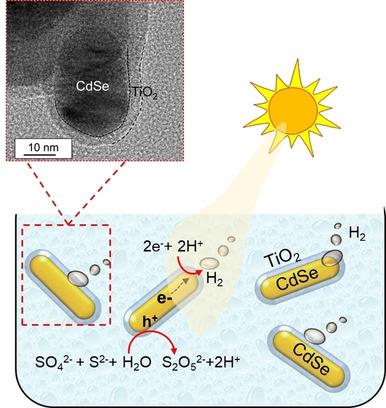当前位置:
X-MOL 学术
›
ChemCatChem
›
论文详情
Our official English website, www.x-mol.net, welcomes your
feedback! (Note: you will need to create a separate account there.)
Retorting Photocorrosion and Enhanced Charge Carrier Separation at CdSe Nanocapsules by Chemically Synthesized TiO2 Shell for Photocatalytic Hydrogen Fuel Generation
ChemCatChem ( IF 3.8 ) Pub Date : 2020-03-23 , DOI: 10.1002/cctc.202000184 Vempuluru Navakoteswara Rao 1 , Sudhagar Pitchaimuthu 2 , Parnapalle Ravi 3 , Marappan Sathish 3 , Hyungkyu Han 4 , Shankar Muthukonda Venkatakrishnan 1
ChemCatChem ( IF 3.8 ) Pub Date : 2020-03-23 , DOI: 10.1002/cctc.202000184 Vempuluru Navakoteswara Rao 1 , Sudhagar Pitchaimuthu 2 , Parnapalle Ravi 3 , Marappan Sathish 3 , Hyungkyu Han 4 , Shankar Muthukonda Venkatakrishnan 1
Affiliation

|
Metal chalcogenide‐based semiconductor nanostructures are promising candidates for photocatalytic or photoelectrocatalytic hydrogen generation. In order to protect CdSe from photocorrosion, a layer of TiO2 wrapped (shell) onto CdSe (core) nanocapsule via the post‐synthesis process. The morphology studies confirm that a thin crystalline TiO2 shell (3–8 nm) wrapped in all the three directions onto CdSe core and thickness of the shell can be controlled through modulating the titania precursor concentration. The feasibility of pristine CdSe nanocapsules and CdSe@TiO2 in transforming visible light to hydrogen conversion was tested through photocatalysis reaction. The CdSe@TiO2 nanocapsules generated a four‐fold high rate of hydrogen gas (21 mmol.h−1.g−1cat) than pristine CdSe. In order to understand the role of shell@core, we have studied the photoelectrochemical and impedance analysis. The CdSe@TiO2 nanocapsules showed higher photoelectric current generation and lower charge transfer resistance at electrode/electrolyte interfaces compared to pristine CdSe. These studies endorse that chemically synthesized crystalline TiO2 shell played a multifunctional role in (a) surface passivation from photocorrosion, (b) promoting photocharge carrier separation via tunneling process between CdSe and TiO2 interface. As a result, CdSe@TiO2 nanocapsules showed a high conversion efficiency of 12.9 % under visible light irradiation (328 mW.cm−2) and a TOF of 0.05018 s−1.
中文翻译:

化学合成的TiO2壳在CdSe纳米胶囊上干馏光腐蚀和增强的电荷载流子分离,用于产生光催化氢燃料
基于金属硫属化物的半导体纳米结构是光催化或光催化氢生成的有希望的候选者。为了保护CdSe免受光腐蚀,通过合成后工艺将TiO 2层包裹(壳)在CdSe(核)纳米胶囊上。形态学研究证实,可以通过调节二氧化钛前体的浓度来控制在所有三个方向上包裹在CdSe核上的薄晶体TiO 2壳(3–8 nm)和壳的厚度。通过光催化反应测试了原始CdSe纳米胶囊和CdSe @ TiO 2将可见光转化为氢的可行性。CdSe @ TiO 2生成纳米胶囊的四倍的氢气的高速率(21 mmol.h -1 .G -1猫)比原始的CdSe。为了了解shell @ core的作用,我们研究了光电化学和阻抗分析。与原始的CdSe相比,CdSe @ TiO 2纳米胶囊在电极/电解质界面处显示出更高的光电电流产生和更低的电荷转移电阻。这些研究支持化学合成的TiO 2结晶壳在(a)光腐蚀表面钝化,(b)通过CdSe和TiO 2界面之间的隧穿过程促进光电荷载流子分离方面起着多功能作用。结果,CdSe @ TiO 2纳米胶囊在可见光照射(328 mW.cm -2)下的转化率为12.9%,TOF为0.05018 s -1。
更新日期:2020-03-23
中文翻译:

化学合成的TiO2壳在CdSe纳米胶囊上干馏光腐蚀和增强的电荷载流子分离,用于产生光催化氢燃料
基于金属硫属化物的半导体纳米结构是光催化或光催化氢生成的有希望的候选者。为了保护CdSe免受光腐蚀,通过合成后工艺将TiO 2层包裹(壳)在CdSe(核)纳米胶囊上。形态学研究证实,可以通过调节二氧化钛前体的浓度来控制在所有三个方向上包裹在CdSe核上的薄晶体TiO 2壳(3–8 nm)和壳的厚度。通过光催化反应测试了原始CdSe纳米胶囊和CdSe @ TiO 2将可见光转化为氢的可行性。CdSe @ TiO 2生成纳米胶囊的四倍的氢气的高速率(21 mmol.h -1 .G -1猫)比原始的CdSe。为了了解shell @ core的作用,我们研究了光电化学和阻抗分析。与原始的CdSe相比,CdSe @ TiO 2纳米胶囊在电极/电解质界面处显示出更高的光电电流产生和更低的电荷转移电阻。这些研究支持化学合成的TiO 2结晶壳在(a)光腐蚀表面钝化,(b)通过CdSe和TiO 2界面之间的隧穿过程促进光电荷载流子分离方面起着多功能作用。结果,CdSe @ TiO 2纳米胶囊在可见光照射(328 mW.cm -2)下的转化率为12.9%,TOF为0.05018 s -1。











































 京公网安备 11010802027423号
京公网安备 11010802027423号